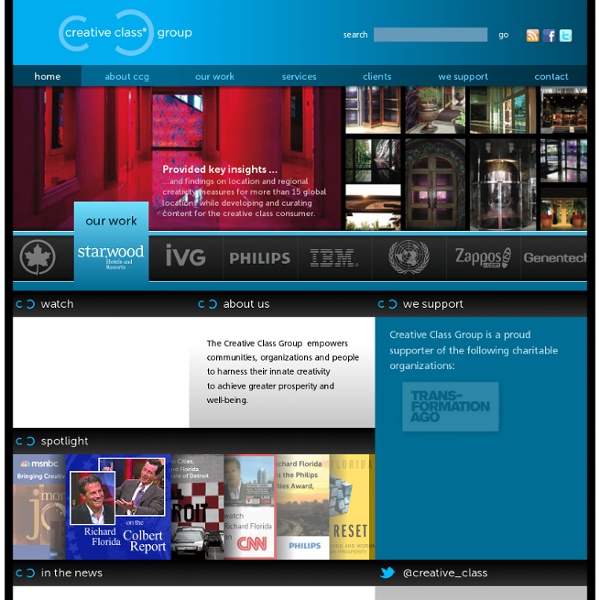



Poderopedia Climate Change Knowledge Portal 2.0 Explore and use a collection of development, vulnerability, and impact-related indicators and datasets. Climate Adaptation Country Profiles provide a quick reference source for development practitioners to better integrate climate resilience into development planning and operations. Learn from several examples of emerging economies actively seeking to move toward a low carbon growth path. WORLD BANK FINANCED ACTIVITIES Explore Navigate and learn more about World Bank Financed Activities and Projects. Ideas in development | Just another WordPress.com site Ciudad Emergente | Laboratorio para el Urbanismo Ciudadano BIT CITY 2011 | Transportation, Data, and Technology in Cities
Resumen del 2011: 1er trimestre Como estamos próximos al fin de año, hemos realizado una selección de los post que marcaron pauta durante el año 2011. A continuación les presentamos los principales temas que destacaron el primer trimestre de este año, entre los que destacan las Políticas energéticas, desarrollo de espacios y parques públicos en Santiago, aprobación del PRMS100 por parte del CORE, y Reconstrucción a un año del terremoto. Política Energética y sustentabilidad ambiental A pesar de la importancia atribuída a nivel mundial al cuidado del medioambiente, aún en Chile no tenemos una política energética clara. Por otro lado, la urgencia de participación se hizo notar, por ejemplo, ante la aprobación del proyecto para instalar centrales hidroeléctricas de paso en el Río Achibueno, ocasión en que la municipalidad de Linares logró interponer un recurso de protección frente al proyecto, el cual fue resuelto favorablemente para el municipio. Río Mapocho Reconstrucción Santiago turístico y comercial
2011: The Year in Sustainability Without a doubt, the year 2011 has been a remarkable year in the journey to a sustainable future. There have been some exhilarating highs and some devastating lows. While a steady drumbeat of warnings about climate destabilization persists, growing ever louder, the response seems to finally be an awakening of consciousness of the need to take action. Sustainability is finally becoming mainstream. But is it happening fast enough? Let’s begin by looking at the environment, because without that, all the other stories become irrelevant. Greenhouse gases rose to record levels, Arctic sea ice melt almost reached the record set in 2007 and, despite being a “La Niña” year, when temperatures are supposed to be cooler than average, it turned out to be the 11th hottest year on record. It was a year in which temperature extremes became the new normal here in the US, with close to 3,000 monthly temperature records being broken, along with droughts and heat waves across the globe.
The Enabling City | The Power of the Everyday ECPA Urban Planning Initiative » Blog Archive » The World Bank Eco2 Cities Initiative: Ecological Cities as Economic Cities Launched in 2009 by the World Bank, the Eco2 Cities Initiative seeks to establish a new paradigm of economic development for cities in developing countries. It couples economic development and sustainability as interdependent; making sustainable economic development necessary to the future success of cities. The initiative is defined by four principals (World Bank, 2011): “A City Based Approach.” The above principals are based on the experiences of six different cities’ recent attempts to sustainably tackle the effects of climate change while fostering economic growth. Eco2 Case Study 1: Curitiba, Brazil Curitiba, Brazil, a metropolitan area of 3.26 million people, sought a cost effective and highly integrated approach to sustainable economic development. According to Friberg (2000), Curitiba’s BRT system cost (US) $8 to $12 million per kilometer to construct, while a typical subway costs (US) $50 to $100 million/kilometer (p. 154). Written by Daniel Brooks with Brett Roeth & Zoe Koven
Urban-Think Tank - Join Click here to donate to U-TT. Through donations, we are able to take on projects in underprivileged communities for free or little cost. Alternatively, contact us to find out how you may support us through other means. We are offering volunteers the chance to work with U-TT, in the framework of specific projects and internship programs. As a non-profit organization, we are continuously engaged in non-academic, stakeholder and community driven initiatives, which are in need of volunteers. If you are interested in volunteering for a period of time, please write to us with your special interests and skills. We are always looking for talented and creative people.
What Are Small Streets? - Small Streets Jessup Street, Philadelphia. Image credit: Matt O’Hara Small streets have been around for thousands of years. For centuries they were part of the dominant pattern of development by humans in both large cities and small towns. The industrial revolution, modern centralized town planning, and the personal automobile contributed to the decline of the small street in North America. Small streets are most simply defined as streets less than 30 feet wide measured from building to building. Churchill Street, Baltimore. Often small streets include curbs and sidewalks to separate automobiles and pedestrians, but the best and most charming small streets are shared spaces with no curbs. Imai-Cho, Nara, Japan. Throughout much of the world, small streets exist in organic patterns, intersecting with other small streets as well as wider streets.